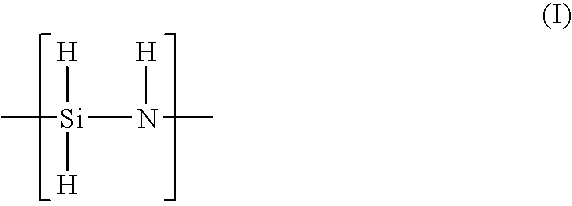Hydrophilization-accelerating and hydrophilicity-keeping agents for polysilazane-containing coating films
a technology of hydrophilicity maintaining agent and hydrophilicity promoting agent, which is applied in the direction of pretreatment surface, coating, other chemical processes, etc., can solve the problems of distorted transmission image and reflection image, inability to say that the anti-fouling effect was exhibited at a sufficient level over a long time, etc., to achieve the effect of promoting or maintaining hydrophilicity
- Summary
- Abstract
- Description
- Claims
- Application Information
AI Technical Summary
Benefits of technology
Problems solved by technology
Method used
Image
Examples
example 1
[0074] The following compounds in corresponding amounts were mixed together: 9 parts by weight of sodium sec-alkane sulfonate, 12 parts by weight of coconut oil fatty acid amide propyl betaine, 5 parts by weight of polyoxyethylene (an average number of added moles is 8) undecyl alcohol, 3 parts by weight of propylene glycol, 0.3 parts by weight of sodium benzoate and 70.7 parts by weight of water and pH of the solution was adjusted to 6.0 with citric acid. The resulting solution was diluted with water to 3 times, which was used as a hydrophilicity promoting agent.
[0075] Spin coated on a 4-inch silicon wafer at 500 r.p.m. for 20 sec. was a polysilazane-containing solution including inorganic polysilazane at a content of 3% by weight and 4,4′-trimethylenebis(1-methylpiperidine) at a content of 0.12% by weight and thereafter, the coating film on the silicon wafer was dried in an atmosphere at a temperature of 22° C. and a relative humidity of 30% R.H. for 30 min. A contact angle relat...
example 2
[0077] The following compounds in corresponding amounts were mixed together: 8.4 parts by weight of sodium sec-alkane sulfonate, 3.6 parts by weight of coconut oil fatty acid amide propyl betaine, 5 parts by weight of polyoxyethylene (an average number of added moles is 8) undecyl alcohol, 3 parts by weight of propylene glycol, 0.3 parts by weight of sodium benzoate and 79.7 parts by weight of water and pH of the solution was adjusted to 6.0 with citric acid. The resulting solution was diluted with water to 50 times, which was used as a hydrophilicity maintaining agent.
[0078] Grease was applied on the coating film obtained in Example 1 and a contact angle was measured with a result of 95°. A sponge was soaked with the hydrophilicity maintaining agent above to wash the coating film with the wet sponge. The hydrophilicity maintaining agent was washed away with water to dry the coating film. A contact angle relative to the coating film after drying was 32°, a thickness thereof was 732...
example 3
[0079] The following compounds in corresponding amounts were mixed together: 15 parts by weight of sodium sec-alkane sulfonate, 10 parts by weight of coconut oil fatty acid amide propyl betaine, 3 parts by weight of polyoxyethylene (an average number of added moles is 8) undecyl alcohol, 3 parts by weight of propylene glycol, 0.3 parts by weight of sodium benzoate and 68.7 parts by weight of water and pH of the solution was adjusted to 6.0 with citric acid. The resulting solution was diluted with water to 10 times, which was used as a hydrophilicity promoting agent.
[0080] Spin coated on a 4-inch silicon wafer at 500 r.p.m. for 20 sec. was an inorganic polysilazane solution at a content of 3% by weight (NP-140 made by Clariant Japan K.K.) and thereafter, the coating film on the silicon wafer was dried in an atmosphere at a temperature of 22° C. and a relative humidity of 30% R.H. for 30 min. A contact angle relative to the coating film at this time is 80°, a thickness thereof was 72...
PUM
| Property | Measurement | Unit |
|---|---|---|
| temperature | aaaaa | aaaaa |
| temperature | aaaaa | aaaaa |
| inner volume | aaaaa | aaaaa |
Abstract
Description
Claims
Application Information
 Login to View More
Login to View More - R&D
- Intellectual Property
- Life Sciences
- Materials
- Tech Scout
- Unparalleled Data Quality
- Higher Quality Content
- 60% Fewer Hallucinations
Browse by: Latest US Patents, China's latest patents, Technical Efficacy Thesaurus, Application Domain, Technology Topic, Popular Technical Reports.
© 2025 PatSnap. All rights reserved.Legal|Privacy policy|Modern Slavery Act Transparency Statement|Sitemap|About US| Contact US: help@patsnap.com

